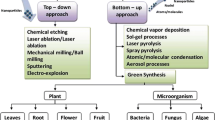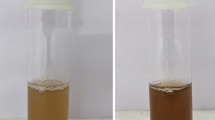Abstract
A sol-gel method is used to fabricate a smart reusable electrochemical sensor Ag@SiO2 Gel (silver-silicate) for the detection of sulfur-based compounds sulfide S2− and thiourea TU based on the oxidative cycle of Ag0/Ag+. In this method, adding chemically prepared AgNPs silver nanoparticles and cetylammonium bromide CTAB are mixed with solution containing TEOS tetraethoxysilane, ethanol, H2O and NH3 ammonia for stirring 120 mins. The sensor was characterized by UV − visible absorption, emission, FTIR spectroscopy, scanning electron microscope (SEM) and electrochemical studies. The plasmonic band AgNPs appeared at 430 nm and the frequency of Ag-O in the sensor appeared at 550 cm−1 for the sensor. Electrochemical studies of sensor recorded the oxidation Ox and reduction Red potentials of AgNPs at +500 and −250 mV, respectively, which confirms linkage of AgNPs to silicon framework. At optimized conditions, the linearity of peak current of the Ox potential observed 10.0–20.0 μM for S2− and TU, with correlation coefficient (R2,0.98). The detection limits are calculated 1.88 and 2.14 μM of S2− and TU, respectively. The sensor had good reproducibility (RSD < 2.0%, n = 5). The density functional theory DFT was used to demonstrate the bond strength between AgNPs and S2− or TU. The results of the BDE bond dissociation energy and the bond order of Ag-S, AgNPs were a faster dissolution with S2− than TU. The operation of the gel sensor has been returned with the addition of 50 μM HCl without wasting it. It’s a new trend for electrochemical sensors.
Graphical Abstract

Highlights
-
The Sol-gel method is used to prepare a smart and reusable Ag@SiO2 gel as electrochemical sensor.
-
The plasmonic band AgNPs was recorded for Ag@SiO2 gel.
-
Limit of detection for electrochemical detection of s2− (sulfide) and TU(thiourea) was 1.88 and 2.14, respectively.
-
DFT was used to demonstrate the bond strength between AgNPs and S2− or TU.
-
The operation of the gel sensor has been returned with the addition of 50 μM HCl






Similar content being viewed by others
References
Mehta S, Verma R (2013) Seed yield and economics of chickpea (Cicer arietinum) as influenced by foliar application of agrochemicals. Indian J Agric Res 47(4):359–362
Gao M, Feng L, Jiang T (2014) Browning inhibition and quality preservation of button mushroom (Agaricus bisporus) by essential oils fumigation treatment. Food Chem 149:107–113. https://doi.org/10.1016/j.foodchem.2013.10.073
Gholap S, Dod V, Bhuyar S, Bharad S (2000) Effect of plant growth regulators on seed germination and seedling growth in aonla (Phyllanthus emblica L.) under climatic condition of Akola. Crop Res (Hisar) 20(3):546–548
Mandrou B, Brun S, Kingkate A (1977) Quantitative determination of thiourea in citrus fruits. J Assoc Off Anal Chem 60(3):699–701
Wang LK, Hung YT, Lo HH, Yapijakis C (2004) Treatment of pulp and paper mill wastes. Handbook of industrial and hazardous wastes treatment. Second edition, Marcel Dekeer Inc (USA) CRC Press, p 507–555
Maratovna SA, Suiynbaevna AM, Qdirbayuli BY (2022) The use of Sodium Sulfide in Production. American. J Soc Human Res 3(3):198–200
Francis RC, Vaporidi K, Bloch KD, Ichinose F, Zapol WM (2011) Protective and detrimental effects of sodium sulfide and hydrogen sulfide in murine ventilator-induced lung injury. J Am Soc Anesthesiol 115(5):1012–1021
Bakir EM, Karnati RK (2022) Preparation of Luminescent Plasmonic Silver Nanoparticles for Electrochemical Detection of Sulphide and Thiourea in Aqueous Solution and Ab Initio DFT Study of the Chemical Affinity Towards Silver Nanoparticles. Plasmonics 17(3):1–8
Privett BJ, Shin JH, Schoenfisch MH (2010) Electrochemical sensors. Anal Chem 82(12):4723–4741
Shafi M, Bahader A, Gul FS, Khan MI, Farooqi K (2022) Ag-rGO Nanocomposite as an Efficient Electrochemical Sensor for Thiourea. ECS Adv 1(3):036503
Ahmed J, Faisal M, Alsareii S, Jalalah M, Harraz FA (2022) Sensitive Electrochemical Detection of Thiourea Utilizing a Novel Silver Nanoparticle-Decorated Porous Silicon-Polyaniline Nanocomposite. J Electrochem Soc 169(8):087507
Jiang H, Wang B, Tang R, Tan Y, Qi M, Zhang X (2023) Inhibition to dual enzyme-like activities of Ag/CeO2 nanozymes for the detection of thiourea. Microchem J 185:108251
Shafi M, Bahader A, Gul FS, Khan MI, Farooqi K (2022) Ag-rGO Nanocomposite as an Efficient Electrochemical Sensor for Thiourea. ECS Adv 1(3):036503
Bakir EM, Karnati RK (2022) Preparation of Luminescent Plasmonic Silver Nanoparticles for Electrochemical Detection of Sulphide and Thiourea in Aqueous Solution and Ab Initio DFT Study of the Chemical Affinity Towards Silver Nanoparticles. Plasmonics 17(3):1017–1024. https://doi.org/10.1007/s11468-022-01592-0
Dadosh T (2009) Synthesis of uniform silver nanoparticles with a controllable size. Mater Lett 63(26):2236–2238
Al Otaibi N, Bakir E, Afkar E (2019) Efficient alum and iron supported on silica matrix as gel coagulants for advance chemical treatment of dairy product effluents. J Sol-Gel Sci Technol 92(3):529–536
Hay PJ, Wadt WR (1985) Ab initio effective core potentials for molecular calculations. Potentials for the transition metal atoms Sc to Hg. J Chem Phys 82(1):270–283
Rassolov VA, Ratner MA, Pople JA, Redfern PC, Curtiss LA (2001) 6‐31G* basis set for third‐row atoms. J Comput Chem 22(9):976–984
DiLabio GPD, LoFaro A, Wright JS (1999) Theoretical study of X−H bond energetics (X=C, N, O, S): application to substituent effects, gas phase acidities, and redox potentials. J Phys Chem A 103(11):1653–1661
Wiberg K (1968) analysis in Löwdin orthogonalized basis. Tetrahedron 24:1083–1096
Liang Y, Ouyang J, Wang H, Wang W, Chui P, Sun K (2012) Synthesis and characterization of core–shell structured SiO2@ YVO4: Yb3+, Er3+ microspheres. Appl Surf Sci 258(8):3689–3694
Waterhouse GI, Bowmaker GA, Metson JB (2001) The thermal decomposition of silver (I, III) oxide: A combined XRD, FT-IR and Raman spectroscopic study. Phys Chem Chem Phys 3(17):3838–3845
Siddiqui MRH, Adil S, Assal M, Ali R, Al-Warthan A (2013) Synthesis and characterization of silver oxide and silver chloride nanoparticles with high thermal stability. Asian J Chem 25(6):3405–3409
Ro JC, In JC (1991) Structures and properties of silica gels prepared by the sol—gel method. J Non-crystalline Solids 130(1):8–17
Alberg I (2021) Absorption Spectroscopy Studies of Silicon Dioxide Nanoparticles and Their Applications in Solar Cells. Eesti Maaülikool, 32–33.
Alim-Al-Razy M, Bayazid GA, Rahman RU, Bosu R, Shamma SS (2020) Silver nanoparticle synthesis, UV-Vis spectroscopy to find particle size and measure resistance of colloidal solution. J Phys: Conf Ser 1:012020. IOP Publishing
Pan A, Yang Z, Zheng H, Liu F, Zhu Y, Su X, Ding Z (2003) Changeable position of SPR peak of Ag nanoparticles embedded in mesoporous SiO2 glass by annealing treatment. Appl Surf Sci 205(1-4):323–328
Li T, Moon J, Morrone AA, Mecholsky JJ, Talham DR, Adair JH (1999) Preparation of Ag/SiO2 nanosize composites by a reverse micelle and sol– gel technique. Langmuir 15(13):4328–4334
Giovanni M, Pumera M (2012) Size dependant electrochemical behavior of silver nanoparticles with sizes of 10, 20, 40, 80 and 107 nm. Electroanalysis 24(3):615–617
Choi Y-J, Luo T-JM (2011) Electrochemical properties of silver nanoparticle doped aminosilica nanocomposite. Int J Electrochem. 2011:6. https://doi.org/10.4061/2011/404937
Fox CM (2014) Electrochemical Synthesis of Silver Nanoparticles for Applications in Nitrate Detection, Catalysis and Antibacterial Activity. National University of Ireland, Maynooth (Ireland), p 61–100
Campbell FW, Compton RG (2010) The use of nanoparticles in electroanalysis: an updated review. Anal Bioanal Chem 396(1):241–259
Luo Y-R (2002) Handbook of bond dissociation energies in organic compounds. CRC press, p 392
Trung NQ, Mechler A, Hoa NT, Vo QV (2022) Calculating bond dissociation energies of X− H (X= C, N, O, S) bonds of aromatic systems via density functional theory: a detailed comparison of methods. R Soc Open Sci 9(6):220177
Loza K, Diendorf J, Sengstock C, Ruiz-Gonzalez L, Gonzalez-Calbet J, Vallet-Regi M, Köller M, Epple M (2014) The dissolution and biological effects of silver nanoparticles in biological media. J Mater Chem B 2(12):1634–1643
Wang GL, Dong YM, Zhu XY, Zhang WJ, Wang C, Jiao HJ (2011) Ultrasensitive and selective colorimetric detection of thiourea using silver nanoprobes. Analyst 136(24):5256–5260
Loyprasert S, Thavarungkul P, Asawatreratanakul P, Wongkittisuksa B, Limsakul C, Kanatharana P (2008) Label-free capacitive immunosensor for microcystin-LR using self-assembled thiourea monolayer incorporated with Ag nanoparticles on gold electrode. Biosens Bioelectron 24(1):78–86
Ardelean M, Manea F, Vaszilcsin N, Pode R (2014) Electrochemical detection of sulphide in water/seawater using nanostructured carbon–epoxy composite electrodes. Anal Methods 6(13):4775–4782
Lu Z, Chen M, Liu T, Wu C, Sun M, Su G, Wang X, Wang Y, Yin H, Zhou X, Ye J, Shen Y, Rao H (2023) Machine Learning System To Monitor Hg2+ and Sulfide Using a Polychromatic Fluorescence-Colorimetric Paper Sensor. ACS Appl Mater Interfac 5(7):9800–9812. https://doi.org/10.1021/acsami.2c16565
Rahman MM, Alam MM, Alfaifi SY, Asiri AM, Ali MM (2021) Sensitive Detection of Thiourea Hazardous Toxin with Sandwich-Type Nafion/CuO/ZnO Nanospikes/Glassy Carbon Composite Electrodes. Polymers 13(22):3998. https://doi.org/10.3390/polym13223998
Pedre I, Méndez DeLeo L, Sánchez-Loredo MG, Battaglini F, González GA (2016) Electrochemical sensor for thiourea focused on metallurgical applications of copper. Sens Actuators B: Chem 232:383–389. https://doi.org/10.1016/j.snb.2016.03.154
Funding
The authors extend their appreciation to the Deputyship for Research and Innovation, Ministry of Education in Saudi Arabia, for funding this research work (Project INST122).
Author information
Authors and Affiliations
Contributions
RKK and EMB performed material preparation, data collection, and analysis. EMB contributed to the study of conception and design. The first draft of the paper was written by EMB, and all the authors commented on the previous versions of the paper. All the authors read and approved the final paper.
Corresponding author
Ethics declarations
Conflict of interest
The authors declare no competing interests.
Consent to Participate
Informed consent was obtained from all the authors.
Consent for Publish
I consent to the publication of my original research paper.
Ethics approval
I have followed the ethical principles and accurate references to scientific sources in my original paper.
Additional information
Publisher’s note Springer Nature remains neutral with regard to jurisdictional claims in published maps and institutional affiliations.
Rights and permissions
Springer Nature or its licensor (e.g. a society or other partner) holds exclusive rights to this article under a publishing agreement with the author(s) or other rightsholder(s); author self-archiving of the accepted manuscript version of this article is solely governed by the terms of such publishing agreement and applicable law.
About this article
Cite this article
Karnati, R.K., Bakir, E.M. Smart and reusable electrochemical sensor based on Ag@SiO2 gel for the detection of sulfur-based compounds in environmental samples. J Sol-Gel Sci Technol 106, 869–876 (2023). https://doi.org/10.1007/s10971-023-06116-8
Received:
Accepted:
Published:
Issue Date:
DOI: https://doi.org/10.1007/s10971-023-06116-8




